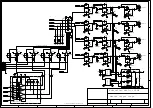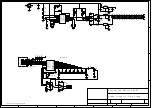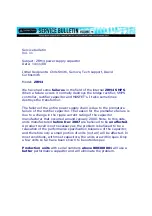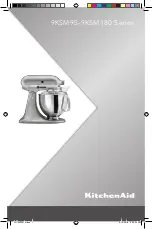
PAG E 8
A M I S Z R M 4 I N S TA L L AT I O N & O P E R AT I O N M A N UA L
TO N E C O N T R O L S
Each input channel includes bass and treble trim pots which may be
used to adjust the tone of the signal. The bass trim /- 12dB of
cut/boost to signals at 100Hz. The treble trim /- 10dB of
cut/boost to signals at 10kHz.
Using the bass cut in association with the high pass filter is useful for
further reduction of rumble from microphones.
NOTE: Attempting to add bass to systems that can not
reproduce bass well (such as transformer coupled
ceiling speakers or horn speakers) will only reduce
the headroom of the system and contribute to
distortion.
NOTE: adding bass or treble boost may cause the
input to clip, so keep an eye on the input’s status LED,
and reduce the gain trim if required.
P R I O R I T Y OV E R R I D E
Each output channel has the ability to mute all other input signals in
the selected output when there is signal present on channel #1,
if channel #1 is assigned to that output. To enable this function activate
(press in) the "CH1 Priority Enable" switch for the required output and
assign channel #1 to that output. This is useful for paging microphones,
juke boxes and other situations where an occasional signal needs to
interrupt the normal programme.
R E M OT E VO L U M E C O N T R O L
The level of each output may be controlled via a RC1 remote level
control panel or 500k ohm log (A) pot. For each output there are two
pins on the connector labeled VCA on the rear panel. The RC1or 500k
ohm log (A) pot should be connected to these pins. Please note that the
remote level control inserts before and in-line with the output level
control so the RC1 sets the maximum output level (for normal signals)
and the front panel master attenuates from that level. Also note that
an RC1 control will have no effect on the signals from input channel #1
or any of the tones generated by the tone module This is so that
the paging can not be turned off in a zone it has been assigned to.
If paging is too loud in a zone, the master output level control for
that zone should be turned down.
NOTE: If using a 500k ohm pot, the connections should
be made to the wiper terminal and the anti-clockwise
terminal. i.e. max resistance = max volume
TO N E M O D U L E
The tone module generates four separately triggerable and
priorioritised tones. They are listed in order of highest to lowest
priority. Each tone is triggered by shorting the "COM" pin of the tone
module control lines connector to its associated pin.
EVAC - An evacuation signal. Triggered by shorting the EVAC pin to
the COM pin. The EVAC signal will continue until the short is removed.
Triggering the EVAC signal will mute all inputs except channel #1.
ALERT - An ALERT/alarm signal. Triggered by shorting the "ALERT"
pin to the "COM" pin. The ALERT signal will continue until the short
is removed. Triggering the alarm signal will mute all inputs except
channel #1.
BELL - A chime like a BELL being struck twice, a short gap and then
repeated. Triggered by shorting the "BELL" pin to the "COM" pin.
The BELL signal will continue until the short is removed.
PRE-ANNOUNCE - A four note chime, suitable for use before a
page is made. Triggered by shorting the "PRE" pin to the "COM" pin.
The PRE-ANNOUNCE chime will sound only once for each time
the chime is triggered.
NOTE: The bell and pre-announce chimes are routed
with signals from channel #1, thus any output which
has channel #1 assigned to it will also receive these
tones. The EVAC and ALERT signals are routed to all
outputs AFTER the level controls. This is to ensure
that all zones receive these tones.
NOTE: Because EVAC and ALERT do not mute channel
#1, it is not advisable to connect a continuous source
(such as a radio or CD player) to this input.
A DVA N C E D F E AT U R E S
☛
☛
☛
☛
☛
Содержание AMIS ZRM4
Страница 2: ...6 X 4 ROUTING MIXER INSTALLATION AND OPERATION MANUAL AMIS ZRM4 ...
Страница 3: ......
Страница 10: ...AMIS ZRM4 INSTALLATION OPERATION MANUAL PAGE 9 BLOCK DIAGRAM ...
Страница 11: ...PAGE 10 AMIS ZRM4 INSTALLATION OPERATION MANUAL SPECIFICATIONS ...






































